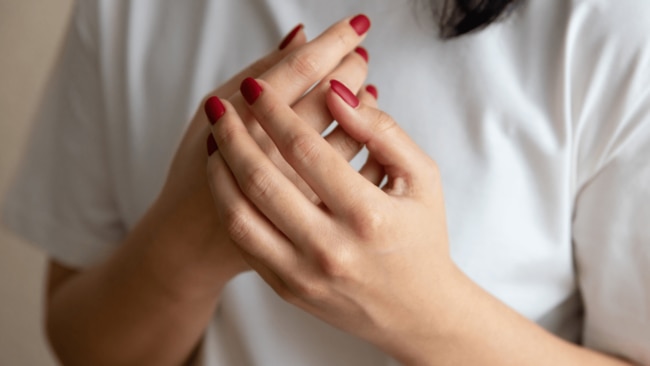If you're going to add one stress relief technique to your day, make it tapping therapy
It's more than skin-deep

Lifestyle
Don't miss out on the headlines from Lifestyle. Followed categories will be added to My News.
Tapping therapy can help people overcome, move through and process a wide range of emotions, including problems, memories, events, and incidents that are impacting their lives including stress. Here's how to do it yourself.
With record numbers of Australians feeling the weight of financial pressure due to the cost-of-living crisis, it's not surprising that an increase in negative psychological effects is being reported, including a rise in anxiety and stress.
While there’s no shortage of stress relief techniques to try – from meditation, deep breathing, exercise, diet, ASMR, and even wearable devices – finding your inner calm in a stressful world can still be a journey with hits and misses along the way.
But there is one approach that you may not have heard of: emotional freedom tapping or, EFT.

While EFT may sound a little hooey, it has proven quite effective in relieving stress, along with assisting other psychological conditions including post-traumatic stress disorder (PTSD) since the practice was founded in the 1990s by Gary Craig, a US-based engineer.
Lorna Hollinger, Australian Tapping Institute CEO says that along with its effectiveness at helping people overcome, move through and process such a wide range of emotions (including problems, memories, events, and incidents that are impacting their lives including stress), it can also help with physical pain.
“Another benefit is using tapping to clear physical aches, pains, and injuries,” she says.

How does tapping work?
Tapping therapy involves “a combination of tapping on specific points of the body (think acupuncture/acupressure points) while engaging in a form of talk therapy delving into what thoughts and memories are upsetting, bothering,” explains Hollinger.
“Tapping on the body is activating the energy circuitry of the body while discussing an upsetting incident. This calms the physical sensations in the body and sends signals back to the brain to release the emotional intensity of the thoughts.
“The past history and events can’t be removed but tapping takes away the automatically triggered response when the thought arises,” she says.
Within her practice, Hollinger has found great success in treating clients with a range of issues from business clients to quiet negative inner voices or imposter syndrome, phobias including agoraphobia and addiction.
“There are so many other great results. I have used tapping to relieve body pains, get people out of panic attacks, move through the trauma of childhood abuse, and release the memories or nightmares of an attack,” she says.
“Right through to helping my brother improve his golf game and win tournaments.”
While tapping can be completed under the guidance of a practitioner, it can also be self-directed.
Intrigued? This is how to do it yourself.

How to do tapping therapy yourself
#1. Find a quiet space
To begin a tapping routine, Hollinger says to start by dedicating five minutes to sitting in a quiet space.
#2. Focus on a specific memory, event, or incident
“Focus on a specific memory, event or incident. Notice what you feel in your body and where you feel it. Notice how intense that feeling is (i.e. a scale of 0-10),” says Hollinger.
Tap through each of the points, 5-6 taps are enough on each point, while telling the story of what happened. Talk through a short story, 2-3 mins of the event/incident max.
“A round is starting at the top of the head point and finishes with under the arm point,” Hollinger says.

#3. Where to tap
12 major meridians mirror each side of the body and correspond to an internal organ. However, EFT mainly focuses on these nine:
- Side of hand, sometimes referred to as “karate chop” (KC): small intestine meridian
- Top of head (TH): governing vessel
- Eyebrow (EB): bladder meridian
- Side of the eye (SE): gallbladder meridian
- Under the eye (UE): stomach meridian
- Under the nose (UN): governing vessel
- Chin (Ch): central vessel
- Beginning of the collarbone (CB): kidney meridian
- Under the arm (UA): spleen meridian
“To do tapping on yourself you just need your own hands,” says Hollinger.
Begin by tapping the side of the hand point while simultaneously reciting your setup phrase three times.
#4. Do three to four rounds
Tap and talk to yourself for three to four rounds. Check in to your body again for the sensations, feelings, and emotions.
“Rate again. If it is not reduced to a 1-2, repeat the process,” Hollinger explains.

If tapping isn’t proving effective Hollinger advises seeing a qualified practitioner who can help guide you through the process, something especially important for those working through more serious issues.
“The reason we use Practitioners is that most people cannot work on their own deeper or more complex issues. The brain packages upsetting memories away so it can be very difficult for us to then access those memories or beliefs on our own.
You can find EFT practitioners online via the Australian Tapping Institute website
More Coverage
Originally published as If you're going to add one stress relief technique to your day, make it tapping therapy





